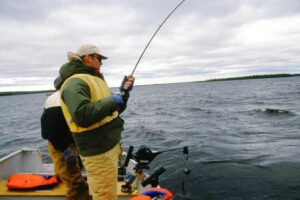For certain fishers, windy days can turn out to be both a blessing and a drawback. You have to know how to turn it in your favor. Springtime is when you can find yourself in the windiest situations. Wind patterns intensify plankton, attracting trout and, ultimately, bigger fish. Windy days can make it difficult to monitor boats and the styles of fishing displays. Anglers must understand how to deal with the air to make the most out of unfavorable environmental conditions. On the days with the most wind, with a few good tips and a little luck to back you up, anglers can get bigger grabs. So here are some tips on how to fish on a windy day. Don’t let the air push you back; you can stand strong against it.
Contents
How does Wind Affect Fishing?
The weather pattern in the US moves to the north throughout the summer, bringing warm blows of low-pressure winds along. This causes those hot summer breezes. The prevailing wind moves south throughout the fall and winter, carrying arctic air and high-pressure wind volumes from the north.
Winds might have a variety of effects on water sources and their inhabitants. The most natural effect is to create waves. Winds cause friction when they pass over the ocean’s surface. A higher force of wind means stronger friction, which leads to more waves.
Waves can enhance water turbidity by drawing currents and compounds with them. All the aspects have an impact on how fish respond in this scenario.
Behavior Change in Fish
A rise in air density can trigger a feeding frenzy in fish. Dramatic weather fluctuations cause sudden transitions in barometric pressure, which is why that can be the right times to damp your line.
Fish had to evolve several physical mechanisms in order to live in water.
One of them is the lateral line which is actually an organ that fish use to move and detect food. It identifies even the smallest resonances in the water and, as a result, is extremely vulnerable to change in the barometric pressure.
Another organ is the swim bladder which is a stomach-like organ that can amplify with air, allowing the fish to gain buoyancy. The stress on a fish’s swim bladder can shift with the changing pressure in the air.
Fish with bigger swim bladders (such as trout) are more resilient to variations in barometric pressure shift. Fish with smaller bladders are not affected as much. Then there are fish like tuna that does not have a swim bladder at all.
Look at the Positive(s)
The wind has an interesting habit of spinning up water and moving it in a specific route before it encounters friction. When the wind hits a shore or a spot, it takes baitfish and small prey with it. The bigger species would be seen there, stirred into an eating frenzy and munching on the excess of prey.
Whenever the wind picks up, a smart angler would often seek out a spot, mainland, or coast for guaranteed fishing. No matter what you choose, do not hide in a calm or steady place. it might seem more convenient, but it would prove to be much less effective.
Pick a Place
Identifying a safer place will help you find attack points on windy days. You can take a marker buoy along when the wind seems to be picking up. They are an excellent companion for the wind as they provide a robust sinker and rope wound across the float. Pinpoint the largest depth shift using sonar and tag every single corner with the help of a buoy.
Fish like to remain near the edge of the water and lean toward the leeward side more. Whenever it is windy, drift around the edges of the aquatic home and let your lure of the day swim across the shallower sides.
Anchoring is on the Table
Fishing in a series of specific coastal places can cause boat command in the wind to be highly challenging. It can lead to any fishing being mediocre at most. Under these cases, doing what most of the bassers fear might potentially pay off, which is anchoring up. Many anglers consider anchoring as a dying practice, but it can prove beneficial in the wind. So line the cast to the frame, and then lower the anchor. You are ready to fish out without stressing over losing control of the boat.
Seek Shelter
On windy days, anglers can be driven from smooth waterways, but there are always chances to catch fish. Find places where the wind is roaring on one side and the water looks calm on the other side. You can sail through the rough water smashing around the edges by positioning the boat on the side where it is safer. Such locations are great for basses to rest and attack any trout or bait washed in by the tides.
Tips on How to Fish in the Wind
– Backhand casting is an excellent way for coping with varying wind patterns. Proceed by moving sideways and having a 180-degree forward cast away from the target. Shift your head in your target’s direction as the line is being unrolled. The fly would land gently as you ensure the backcast is smooth with a firm stop.
– When you are not casting, keep the rod tip inside or above the water. Keeping the rod in an elevated position causes the wind to create unnecessary stiffness in the line, reducing the efficiency of the cast.
– Strengthen the haul on the stroke heading into the wind, and make sure it’s eased up as the stroke goes along the wind. While with the wind, the jet might have way too much velocity, since the blimp helps the air to aid it in unrolling gently. You can test it out by changing the loop outline from backcast to forward cast and likewise.
– Safety must always come first, particularly in windy conditions. Before you step out to fish, double-check that the gear is in good working condition. Check if all the stuff is tightly fastened and that all the tools and motor batteries are fully charged. Do not leave any loose object lying about. You can keep them in safe compartments and leave them at the shore.
– Use proper lures and baits. (Crankbait or topwater bait might be the best choice in this situation).
Final Thoughts
Wind may be either a positive or a negative thing when it comes to fishing. Wind increases bass fishing scenarios. It disrupts the food chain, leads fish to eat, and cracks open the surface. It makes it difficult for the fish to see the angler or their baits.
Wind can also be harmful at times. It can ruin a fishing bite, cause the boat to lose control, and can put you at risk. If you find the wind is too strong to keep your boat steady, it’s better to go towards the shore as quickly as you can.

